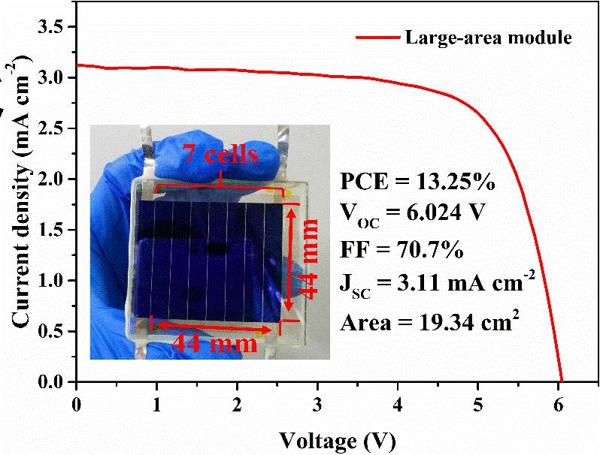Organic solar cells (OSCs) have many advantages such as low cost, light weight, and flexibility. They have broad prospects and have become one of the most important directions in photovoltaic technologies. Large-area fabrication of organic photovoltaic modules (OPMs) is the key technique to realizing the commercialization of organic photovoltaics. Therefore, it has great practical significance to develop the high-performance large-area OPMs.
At present, the widely used fullerene derivative acceptors generally have high electron affinity and electron mobility, but the inherent huge energy losses and the weak photon-harvesting capacities of fullerenes limited their applications. Meanwhile, the non-fullerene acceptors (NFAs) usually have strong absorption in the near-infrared region (NIR), and their energy levels can be easily adjusted to match the donors, but the carrier mobility of the NFAs is relatively low. Therefore, the synergy of fullerene acceptors and NFAs is an effective strategy to improve the photovoltaic performance of OPMs.
The recent work led by Prof. Yang (Michael) Yang from Zhejiang University published in Photonics Research, 2021, Vol. 9, No. 3 (Ziyan Jia, Zeng Chen, Xu Chen, Jizhong Yao, Buyi Yan, Rui Sheng, Haiming Zhu, Yang (Michael) Yang. 19.34 cm2 large-area quaternary organic photovoltaic module with 12.36% certified efficiency[J]. Photonics Research, 2021, 9(3): 03000324) adopted the quaternary blending strategy, realizing a high-performance large area (19.34 cm2) OPM with a certified efficiency of 12.36 %.

The photo and the corresponding J-V curve of the large-area OPMs
In this work, the fullerene acceptor PC71BM and the NFA ITIC were added in the binary PM6:Y6 components to construct a quaternary blending system. The morphology of the active layer films and the process of charge transfer were optimized, thereby promoting the synergistic improvement of the open-circuit voltage (VOC), the short-circuit current-density (JSC) and the fill factor (FF) of the OPMs. In addition, laser engraving was used in the monolithic module to connect seven sub-cells in series. Finally, an efficiency of 13.25 % (certified as 12.36 %) was achieved. Among them, the total illumination area is 19.34 cm2, with geometrical filling factor of 95.5 %.
The large-area photovoltaic module was demonstrated to charge a cellphone under an indoor LED lamp, revealing its promising applications in the future. The researchers believe that the multicomponent blending strategy as well as the module manufacturing technique are the keys to realize efficient large-area OPMs. Future work will focus on the developing novel and effective manufacturing techniques for large-area OPMs, and optimizing the energy conversion processes in the modules.


